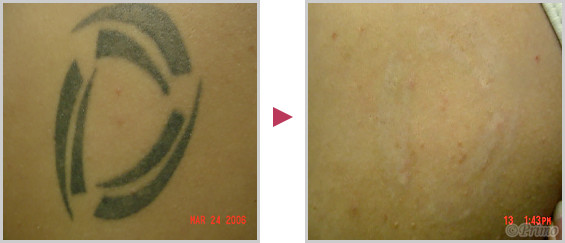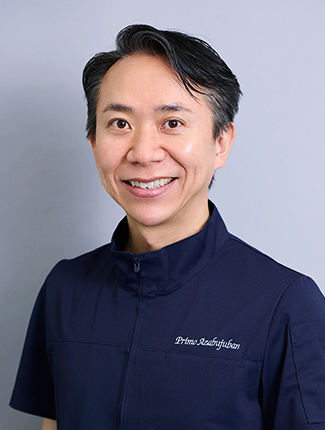The size and shape of your tattoo plus the tension of the skin will be noted when deciding an excision method. The key is how to best utilise the skin surrounding the tattoo.
Method
Excision
We will excise the tattooed area with precision.
Small tattoos can be completed in a single surgery.
Larger tattoos require more work.
Plastic surgical sutures are used so the scars are less noticeable.
Small tattoos may be treated with excision plus flap plasty rather than only simple excision.
For large tattoos, skin grafting can be used depending on the tattoo location and situation.
Laser treatment
Our Q-switched YAG laser is a safe, FDA-approved therapy device.
It can effectively remove some tattoos depending on colour.

Tattoo removal aftercare
Day of treatment
Condition of the affected area
Depending on the shape and size of the tattoo, the length of the scar will vary.
The wound will be uneven, but this will become less noticeable over time.
There may be a tightness of the skin, but the pain is mild.
The swelling will go down in a week or two.
The scar tissue will fully settle in about 6 months.
Bruising may occur around the wound, but it will generally disappear in about 1 to 2 weeks.
There may be numbness, but it is usually temporary.
Normally, skin sensation will return to normal about 6 months after surgery.
Aftercare
You will be examined by the doctor just before you go home after surgery.
We will prescribe antibiotics (to prevent bacterial infection), painkillers, and gastric medicine (to control the side effects of painkillers) for 4 days after surgery.
Lifestyle advice
Depending on your condition, you may be able to take a shower on the day of surgery, but please do not rub the affected area. If the stitches get caught and ripped, this may cause bleeding.
Please try to rest as this is best for wound recovery.
Avoid drinking alcohol, smoking, taking a bath, and strenuous exercise for one week after surgery.
Be very careful not to apply stress to the wound as this may cause it to open.
Try and avoid movement of any joints around the wound.
You can gradually start using the joints within a range that is not too painful.
Refrain from light exercise for one month and strenuous exercise for two to three months.
Painkillers will be used, so you can move around your home normally on the day after surgery.
You can return to desk work 2 to 3 days after surgery.
If you have a job that requires frequent use of the surgical site, it is best to take a week off.
If possible, please use a cushion to elevate the wound when sleeping.
Visit the clinic on day 7 for stitches removal
Condition of the affected area
The wound will be uneven, but this will become less noticeable over time.
The pain will subside, although you may feel a tightness.
The swelling will go down in a week or two.
Things will be completely settled in about 6 months.
Bruising may occur around the wound, but it will generally disappear in about 1 to 2 weeks.
There may be scar redness.
Any redness will vary from person to person, but it will subside in about 1-2 months.
Aftercare
You will be examined by a doctor.
The stitches will be removed on the 7th day.
After the stitches are removed, a special tape will be applied to the wound.
We recommend that you continue wearing the tape for at least 6 months.
Daily routine
On the 7th day after surgery, you will be able to take a bath as usual.
Please be very careful not to put stress on the wound as this may cause it to open.
The movement of the joints around the wound should be minimized.
You can start exercising around the joint gradually within a range that is not too painful.
Refrain from light exercise for one month and strenuous exercise for two to three months.
If you have a job that requires frequent use of the wound site, it is best to have a week off.
If possible, please use a cushion to elevate the wound when sleeping.
Alcohol and smoking may affect the post-operative course, so please continue to refrain from them if you can.
Please visit us for your 1 month and 3 month check-ups
Wound condition
It will gradually fully recover, but there will be some edema and swelling beforehand.
The redness and elevation of the scar will vary from person to person, but everything should settle down in about 6 months.
Aftercare
You will be examined by a doctor at your post-surgery check-ups, but there will be no further surgery.
We recommend that you apply the special tape to the wound for 6 months.
Daily routine
Please be very careful not to apply stress to the wound as this may cause it to open.
Light exercise is possible one month after surgery.
Please refrain from strenuous exercise for two to three months after surgery.
Your 6 month check-up
Wound condition
The wound will almost have completely healed after 6 months.
Aftercare
You will be examined by a doctor, but there will be no further surgery.
Daily routine
After 6 months, there will be no restrictions on any exercise or activities.
You can live your life as usual.
FAQ
It will subside in about two weeks.
Radiofrequency Hyperthermia (CET) will speed up the recovery of swelling and bruising.
You may feel a tightness, but any pain will be mild.
Painkillers will be given, so you can go about your usual home routine from the day after surgery.
You can return to your desk job 2 to 3 days after surgery.
If you have a job that requires frequent use of the surgical site, it is best to take a week off.
Please refrain from light exercise for one month and strenuous exercise for two to three months.
Not at all. We use intravenous anesthesia, so you won’t feel anything during the procedure.
Local anesthesia is also possible depending on the surgical area and your preference.
In our clinic, skin sutures are carefully applied to minimize scars, and special tape is put on after the stitches are removed.
The excess skin, known as dog ears, will be slightly uneven, but this will become less noticeable over time.
Depending on the size and shape of the tattoo, the scar may be slightly larger.
Surgery to reduce a large tattoo usually requires more tension on the sutures, so the wound may take longer to heal.
Fees
All fees include tax.
| Surgery | Remarks | Fees |
|---|---|---|
| Tattoo Removal | 5.0 cm or less in length | ¥220,000 |
| + per 1.0 cm if the length exceeds 5.0 cm | ¥22,000 | |
| The above prices are for the first surgery. There will be 20% off prices for the second surgery, third surgery, etc. | ||
Post-operative course, risks, side effects, and complications
Underneath is a list of things that may happen.
In order to prevent these symptoms from occurring, we take measures for each of them and perform treatment with the utmost care.
We will do our best to improve any symptoms you may experience.
Post-operative course
Swelling
It will recede in 7 – 10 days, and will completely recover in 6 months.
Bruising
It may appear around the affected area, and will vary from person to person, but it will always disappear in 1 – 2 weeks.
Scarring
Scarring is permanent and the scar will extend further than the tattoo area.
Scar redness varies from person to person, but it will subside in 2-3 months.
The scar will be uneven.
After the stitches are removed, we will show you how to apply special tape to the scar for the next six months.
Movement restrictions
Joint movement around the surgical wound will be restricted.
You can gradually start rehabilitation to increase the range of motion.
Dysesthesia
There may be a dull sensation around the wound, but most of the time it is temporary.
Normal sensation will recover about six months after surgery.
Risks, side effects, and complications
Exposure of absorbable sutures
In this case, we will only remove the exposed sutures.
Hematoma
If a hematoma develops, it may need to be removed.
Infection
Although rare, there is a risk of infection with any surgery.
If infection occurs, we will treat it with antibiotics, and if pus has accumulated, we will drain it with a small incision.
Wound accidentally opening
Please note that applying stress to the wound may cause it to open.
In the unlikely event of this occurring, we will re-suture the wound.
Blood circulatory disorder
Please refrain from smoking.
It can be caused by overly tight sutures, or swelling of the wound on the extremities.
In the unlikely event that this happens, open wound surgery will be swiftly required.
Hypertrophic scar
The scar may be red and raised.
Treatment for this includes creams, injections, and oral medications.
If necessary, excision and resuturing will also be done.
Morphological changes
Large lesion resection can change the shape of the surrounding structures.
They can become asymmetrical.
There will always be excess skin called dog ears at both ends of the suture.
Supervising Doctor
Under the supervision of our plastic surgeons, we operate our website in accordance with medical advertising guidelines.
NORIHIRO OHBA M.D. Ph.D.
HEAD DIRECTOR/DIRECTOR

Qualifications and Academic Affiliations
Doctor of Medicine
Board Certified Plastic Surgeon, Japan Society of Plastic and Reconstructive Surgery
Board Certified Aesthetic Plastic Surgeon, Japanese Society of Aesthetic Plastic Surgery
Board Certified Aesthetic Plastic Surgeon, Japanese Society of Aesthetic Surgery
Anesthesiologist certified by the Ministry of Health, Labor and Welfare
Member of International Society of Aesthetic Plastic Surgery (ISAPS)
International Member of American Society of Plastic Surgeons (ASPS)
Member of Japan Society of Cranio-Maxillo Facial Surgery
Member of Japan Society of Laser Surgery and Medicine
Career
Graduated from Osaka City University Faculty of Medicine, 1996
Osaka City University Hospital Plastic and Reconstructive Surgery, 1996-1999
Osaka City University Graduate School of Medicine, 1999-2003
Osaka City University Hospital Plastic and Reconstructive Surgery, 2003-2005
Sano Memorial Hospital Plastic and Reconstructive Surgery, 2003-2005
Daito Central Hospital Plastic and Reconstructive Surgery, 2003-2005
Ritz Cosmetic Surgery Tokyo Clinic, 2005-2008
Primo Azabujuban Clinic, 2009~
Head Director, Primo Medical Corporation, 2011~
Head Director/Director, Primo Azabujuban Clinic, 2020~
